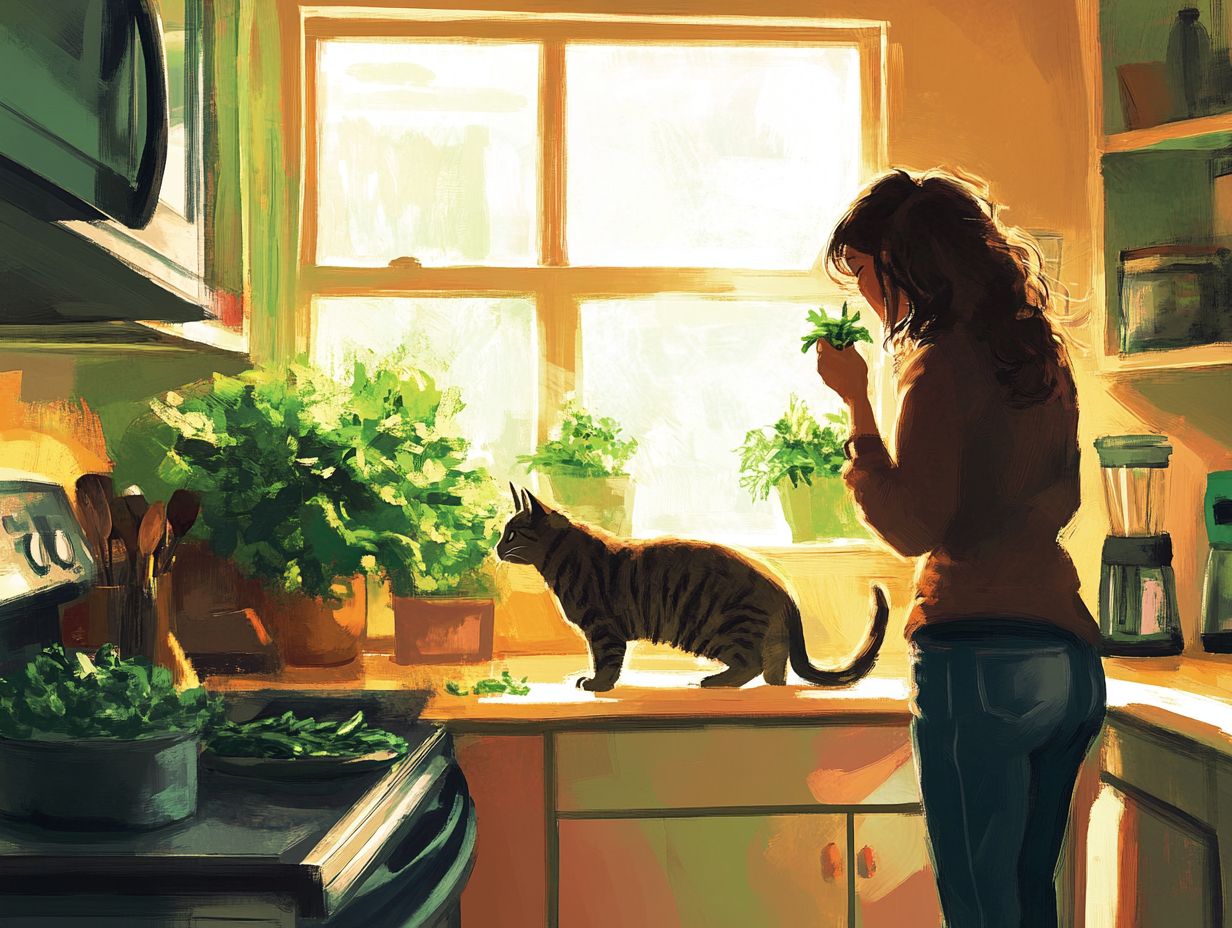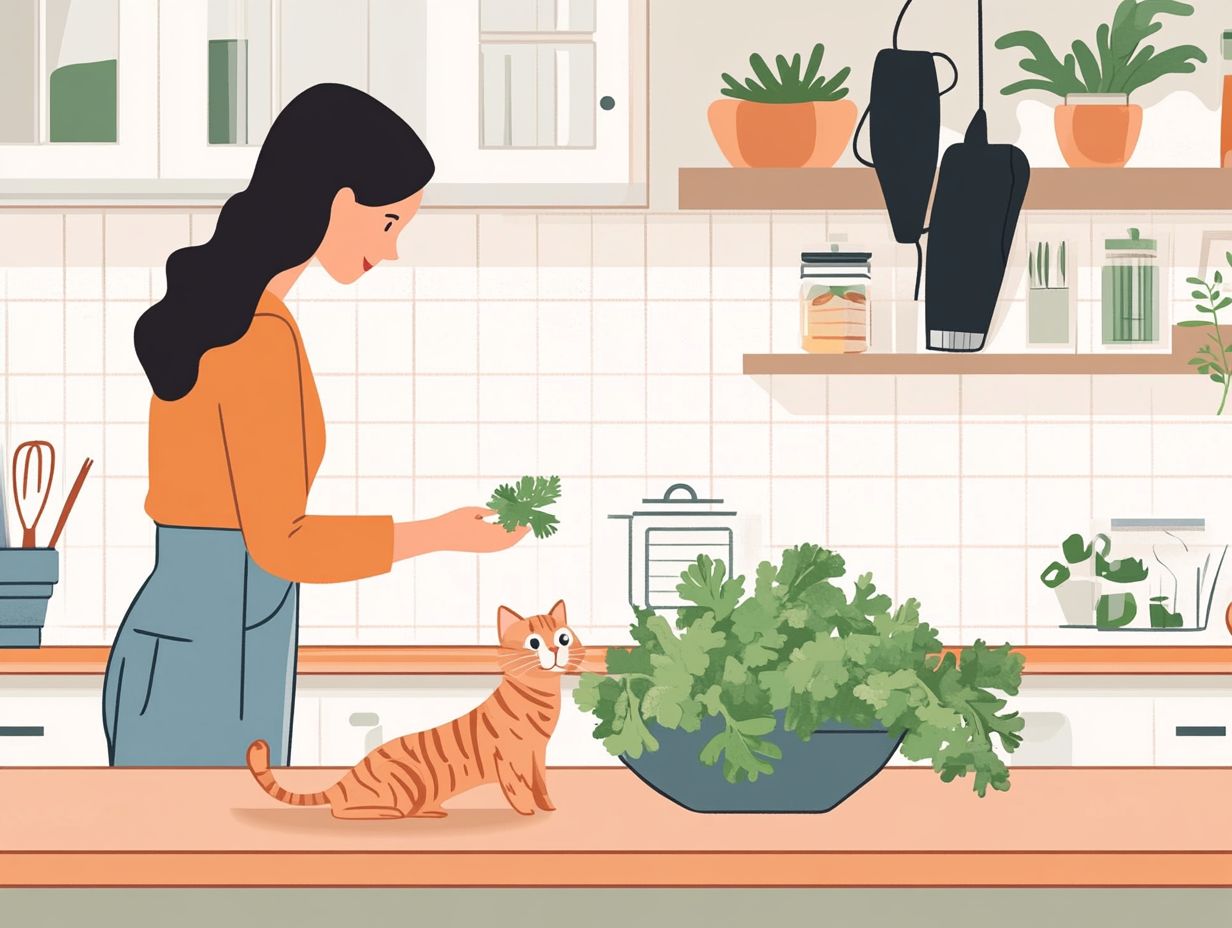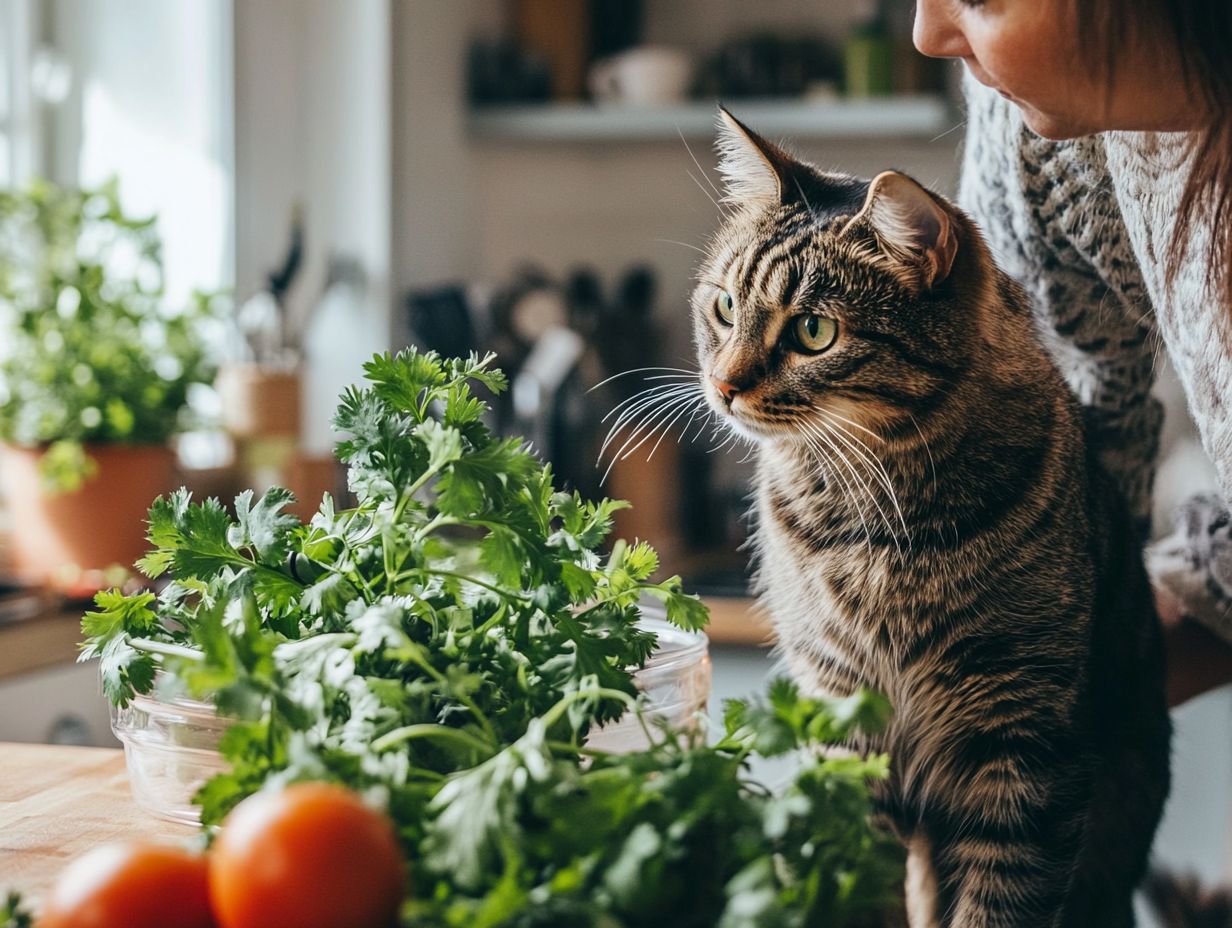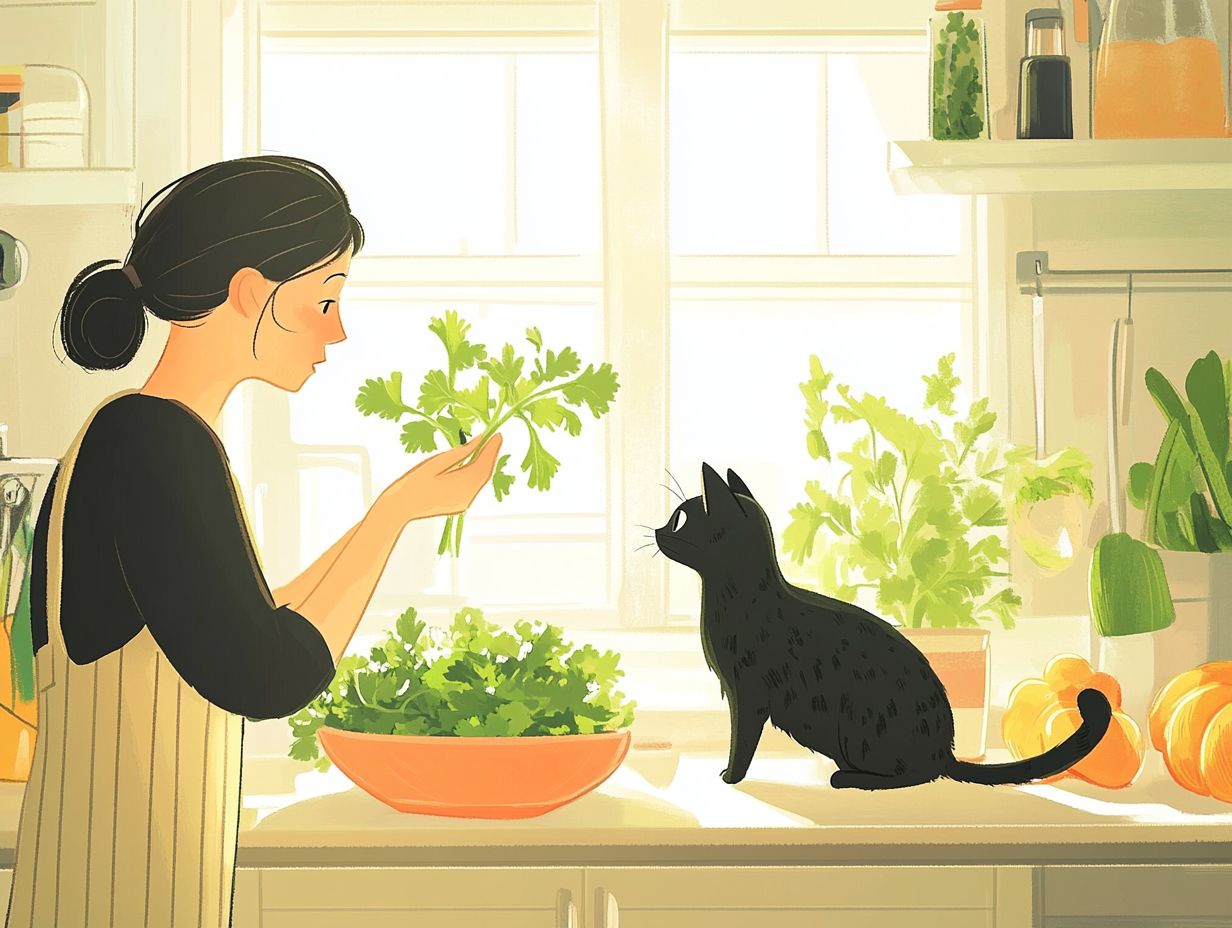Cilantro, or Coriandrum sativum, is a popular herb known for its vibrant flavor, aromatic qualities, and health benefits in human cuisine. But how does it fare for our feline friends? Is cilantro toxic, mildly toxic, or non-toxic to cats? Generally, cilantro is considered non-toxic, but certain parts of the plant may cause issues if consumed in excess.
If you’re a cat owner curious about introducing cilantro into your pet’s diet, it’s important to understand its vitamins, minerals, potential risks, and signs of toxicity, especially if your cat has an allergy. Symptoms of toxicity can range from mild to severe, including:
- Mild: Vomiting, diarrhea
- Moderate: Loss of appetite, lethargy
- Severe: Excessive grooming, arrhythmia
This guide explores safe ways to incorporate cilantro as a natural supplement, suggests alternative herbs, and provides tips for consulting your veterinarian.
Read on to ensure your cat’s safety and well-being!
Key Takeaways:

What is Cilantro?
Cilantro, scientifically known as Coriandrum sativum, is one of the most popular herbs used in cooking, particularly in dishes that require an aromatic and fresh flavor. Renowned for its distinctive taste, cilantro is also rich in a variety of vitamins and minerals that promote the health of both humans and pets. However, if you’re a pet owner, you may wonder, can cats eat cilantro and is it safe?
This versatile herb possesses antioxidant properties and is both a spice and an herb. Notably, all parts of the cilantro plant—stems, leaves, and flowers—are edible.
Can Cats Eat Cilantro?
Yes, cats can eat cilantro in moderation, as it is generally safe and can be a healthy addition to their diet. However, it is important to note that while cilantro offers some nutritional benefits, it should not replace commercial cat food, which is specifically designed to provide the essential nutrients that cats require.
When introducing cilantro into their diet, pet owners should carefully monitor their cats for any gastrointestinal reactions, ensuring that it serves as a natural treat rather than a primary food source.
What Are the Nutritional Benefits of Cilantro for Cats?
Cilantro offers potential health benefits for cats through its rich array of vitamins and minerals. Notably, it contains essential nutrients such as vitamin A, vitamin C, and vitamin K, which support overall feline health and various bodily functions, including immune response and digestion. The antioxidants found in cilantro also help protect cats from oxidative stress, supporting kidney and liver health, which highlights another way it can be beneficial.
Vitamin A promotes healthy vision and skin, while vitamin C is crucial for collagen formation and enhancing the immune system’s response. Vitamin K plays a vital role in blood clotting, ensuring that minor injuries do not result in excessive bleeding. Additionally, cilantro is high in potassium and calcium, both of which contribute to muscle and bone health, respectively. For more information on whether cilantro is safe for your pets, check out Is Cilantro Safe for Cats? Essential Info for Concerned Pet Owners.
By incorporating cilantro into their meals, cats can benefit from a variety of nutrients, including fiber for digestion, that work together to promote a healthy lifestyle.
What Are the Potential Risks of Feeding Cilantro to Cats?
Cilantro is generally safe for cats; however, feeding it to them can pose certain risks that pet owners should be aware of. Some cats may experience allergic reactions or gastrointestinal issues, such as vomiting, diarrhea, or other symptoms.
It is essential for owners to closely monitor their cats after introducing cilantro, as individual reactions to the herb can vary. In particular, they should watch for signs of an adverse response, such as excessive grooming, changes in appetite, or arrhythmia.
First Aid and Treatment Instructions
If a cat shows signs of toxicity after consuming cilantro, follow these steps:
- Remove any cilantro from the cat’s reach.
- Observe the cat for symptoms.
- Contact your veterinarian immediately for advice.
- If symptoms are severe, take the cat to an emergency veterinary clinic.
Prevention Tips
To prevent potential issues, keep cilantro and other plants out of reach of pets. Consider safe alternatives such as catnip or valerian, which are non-toxic and can be enjoyable for cats.
Addressing Common Misconceptions
Many believe that all herbs are safe for cats, but this is not true. Always research before introducing new plants into your pet’s diet.
Special Considerations
Kittens, senior cats, or those with existing health conditions may be at greater risk for adverse reactions. Always consult your veterinarian for tailored advice.
Emergency Contact Information
In case of emergencies, contact the ASPCA Animal Poison Control at 1-888-426-4435.
Consult with your veterinarian for further guidance and insights. This article does not substitute professional veterinary advice. Always keep your pets’ health in mind when considering new dietary changes.
Last reviewed: [Insert Date]. We recommend regular updates as new research emerges.
For more information on other plants that may be toxic or safe for cats, explore related articles on our website.
Cilantro is generally considered non-toxic to cats, though individual sensitivities may occur. For more information on cilantro’s safety, please refer to the ASPCA.
What Are the Signs of Cilantro Toxicity in Cats?

Gastrointestinal disturbances, such as vomiting or diarrhea, may indicate cilantro sensitivity in cats. These symptoms can occur if a cat has an allergic reaction to parts of cilantro, particularly the leaves. However, cilantro is not widely recognized as a toxic herb. Reactions are generally rare and can be categorized as follows:
- Mild Symptoms: Slight vomiting or diarrhea
- Moderate Symptoms: Persistent vomiting or diarrhea
- Severe Symptoms: Severe gastrointestinal distress requiring veterinary attention
If these symptoms arise, consult with veterinary services promptly. It is important to monitor for any unusual behavior or digestive issues following cilantro consumption. If reactions persist, it is crucial to consult a veterinarian for further investigation.
First Aid and Treatment
If you suspect your cat has ingested a large amount of cilantro or is showing symptoms of sensitivity, follow these steps:
- Rinse your cat’s mouth gently with water.
- Monitor your cat for symptoms such as vomiting, diarrhea, or lethargy.
- Contact your veterinarian immediately for advice.
Potential long-term health effects from consuming large amounts of cilantro over time are uncommon, but caution should be exercised.
How to Safely Introduce Cilantro to Your Cat’s Diet
Cilantro should be gradually introduced into your cat’s diet and offered in moderation to ensure that your cat can tolerate it without experiencing any adverse effects. Start by giving your cat small amounts of fresh cilantro leaves or stems, and closely monitor for any signs of gastrointestinal distress or allergic reactions.
It is essential to introduce cilantro in moderation, as it should serve to supplement your cat’s diet without replacing their primary food source, which is rich in essential nutrients.
Alternative Herbs for Cats
Alternative herbs for cats can enrich their diet and provide various health benefits. These herbs can serve as natural treats or supplements. Some beneficial herbs include:
- catnip
- valerian
- dandelion root
- licorice root
- marshmallow leaf
- parsley
- fennel
- thyme
- basil
- dill
- rosemary
- sage
- lemon balm
- peppermint
- cat grass (barley, oats, wheat)
- hibiscus
- yucca
Among these, catnip, valerian, and cat grass are the most popular. These herbal remedies can be used as natural treats or supplements. Proper dosage and administration are essential to ensure their effectiveness and safety.
Incorporating herbs into a cat’s diet not only enhances flavor but also promotes nutrition and enrichment, supporting healthy and varied eating habits.
What Are the Best Herbs for Cats?
The best herbs for cats include catnip, valerian, and dandelion root, each offering distinct health benefits, such as digestion and enrichment experiences for our feline friends. These herbs can significantly enhance a cat’s quality of life in various ways, providing a fun means to improve their overall well-being.
Catnip is the most well-known herb for cats, and most felines enjoy having access to it. It is associated with a euphoric reaction that many cats display, often leading to increased playfulness and activity, thereby stimulating exercise and mental engagement.
Valerian, on the other hand, is beneficial for cats experiencing anxiety and nervousness, helping to calm them and create a more relaxed environment.
Dandelion root is recognized for its support of overall digestion and liver function, ensuring that your cat effectively processes the nutrients from their food.
While these herbs are generally safe for cats, especially when used as a supplement to commercial cat food, it is advisable to introduce any new food or supplement gradually to monitor for any sensitivities.
What Are the Worst Herbs for Cats?
Certain herbs can be dangerous or toxic to cats, so cat owners must be aware of them to avoid inadvertently harming their pets. Common toxic herbs for cats include garlic, onion, and certain types of lilies, which can lead to life-threatening problems if ingested. Identifying which herbs are safe and which are unsafe is crucial for responsible cat care and pet ownership, as emphasized by organizations like the American Society for the Prevention of Cruelty to Animals.
Other common herbs that pose a risk to cats include:
Common Misconceptions
There are several myths surrounding cilantro and its effects on cats. While it is not toxic, some cats may have allergies or sensitivities to it. It is crucial for cat owners to be aware of their pet’s unique reactions to various herbs, including cilantro.
Visual Aids
Consider adding labeled images of cilantro and toxic herbs for easy identification, as well as infographics summarizing cilantro’s safety and symptoms of sensitivity.
If you suspect your cat has ingested a potentially harmful substance, please contact the ASPCA Animal Poison Control Hotline at 1-888-426-4435 for immediate assistance.
Remember to review this article regularly for updates, as new research emerges regarding herbs and their effects on cats. The last review date for this article is October 2023.
Disclaimer: This article is not intended as medical advice. Always consult with your veterinarian before introducing new foods or herbs into your cat’s diet.
- Chives: Often confused with green onions, chives can cause gastrointestinal upset and may lead to more serious health issues over time.
- Catmint and Other Mint Species: While catmint (Nepeta cataria) is known for its euphoric effect on cats, other mint species can be harmful. Their toxicity may result in symptoms such as vomiting and excessive salivation.
Cilantro is generally considered non-toxic to cats, but mild gastrointestinal upset may occur in some cases. This typically involves symptoms like slight vomiting or diarrhea if large amounts are consumed.
Cat owners should remain vigilant about what their pets are exposed to. By exercising caution, gaining knowledge about harmful plants, and consulting with a veterinarian, the risk of harm from these and other toxic herbs can be significantly reduced.
Final Thoughts on Cilantro and Cats

Cilantro can offer some health benefits to cats when introduced correctly and used in moderation; however, it also has potential downsides that pet owners should be aware of. While cilantro is generally safe, it’s important to monitor for any adverse reactions to ensure it positively contributes to your cat’s care. It can be mixed with commercial cat food to provide additional nutrients, including antioxidants and improved digestion, making cilantro a valuable component of a healthy and varied diet for your pet.
Despite its benefits, not all cats may like cilantro or be able to eat it. Some cats may experience allergic reactions, so it’s crucial to observe them when introducing any new food or herb. Most cats are obligate carnivores, meaning they primarily consume meat, and may not enjoy the new flavors of cilantro, garlic, onion, or other common seasonings. A lack of proper nutrients can lead to stunted growth and other health issues, so cilantro alone cannot fulfill all their dietary needs. However, when included in a balanced commercial diet, cilantro can contribute additional micronutrients and healthy compounds.
When introducing new foods, herbs, or supplements into your cat’s diet, it’s best to start slowly, gradually increasing the amount and frequency. If cilantro is not well-received, it should be removed from their diet. Conversely, if cilantro is accepted but other health issues arise, you may consider reducing the amount or frequency of its use. Finding the right balance may take time and experimentation, so changes should be made gradually and with careful observation of your cat’s behavior and health.
In addition, cilantro can enhance a cat’s health as part of a broader care routine. For example, if you notice a sore or scratch on your cat’s skin, it’s important to consult a veterinarian. If cilantro is a regular part of your cat’s diet and the veterinarian later prescribes a check for vitamin deficiency, having cilantro readily available may help mitigate some of those issues as part of a well-balanced diet.
Consulting with Your Veterinarian
Always collaborate with your veterinarian when introducing cilantro or any new food to your cat’s diet. A veterinarian is qualified to provide personalized advice tailored to your cat’s specific health needs.
What to Ask Your Veterinarian About Feeding Cilantro to Your Cat
When discussing the possibility of feeding cilantro to your cat with a veterinarian, consider asking the following questions:
- What is the appropriate serving size for my cat?
- What potential health benefits does cilantro offer for my cat?
- Are there any risks associated with feeding my cat cilantro?
- How does cilantro affect my cat’s specific nutritional needs?
- Does cilantro interact with any medications or health conditions that my cat may have?
- What alternatives to cilantro can provide similar health benefits without the associated risks?
- What role does cilantro play in a balanced diet?
This information will help you make informed dietary choices for your cat, similar to how understanding your own health conditions and lifestyle needs aids in your decision-making. It will ensure that your cat receives a diet tailored to its specific needs, minimizing any unnecessary risks.
How to Tell If Your Cat is Having an Adverse Reaction to Cilantro
Observing your cat for signs of adverse reactions after introducing cilantro is essential for ensuring their safety. Possible symptoms can be categorized as follows:
- Mild Symptoms: slight vomiting, diarrhea, and minor lethargy.
- Moderate Symptoms: persistent vomiting, significant diarrhea, and noticeable discomfort.
- Severe Symptoms: severe lethargy, difficulty breathing, or unresponsive behavior.
If you notice any of these symptoms, especially severe ones, it’s crucial to contact your veterinarian immediately. As a first aid measure, you can withhold food for a few hours and provide fresh water, but always follow up with a vet.
To prevent any adverse reactions, keep cilantro out of reach of your cat or use designated cat-safe areas for plants. This helps minimize the likelihood of accidental exposure.
Common misconceptions include the belief that cilantro is harmful to all cats. Scientific evidence indicates that while some cats may experience mild gastrointestinal upset, cilantro is safe when given appropriately.
Even though cilantro is generally safe, it may cause gastrointestinal upset or allergic reactions in some cats. It’s essential to monitor your pet’s reaction closely.
For visual identification, labeled images of cilantro alongside potentially toxic look-alikes can assist in preventing accidental ingestion.
Legal Disclaimer: This content is for informational purposes only and does not replace professional veterinary advice. Always consult a veterinarian for personalized care.
In case of emergencies, you can contact the ASPCA Animal Poison Control hotline at (888) 426-4435 for assistance.
For future reference, this content will be reviewed and updated as new research emerges regarding cilantro and cats.
For more information, you can read our related articles on other herbs and their effects on cats.
Close monitoring during the introduction phase can help detect any negative reactions early, allowing for prompt veterinary intervention if necessary. It is also important to watch for signs of lethargy and over-scratching, which could indicate allergies or irritations.
Changes in appetite are another critical symptom to consider; if your cat suddenly refuses food or exhibits reduced enthusiasm during feeding times, this may warrant concern. Additionally, monitoring your cat’s coat condition is important; excessive shedding or a loss of luster may signal an adverse reaction.
By tracking these symptoms in the first few days after introducing cilantro, caregivers can provide valuable information to their veterinarian and ensure swift action is taken if an adverse reaction occurs.
Potential Symptoms of Adverse Reactions
- Mild: Lethargy, mild scratching.
- Moderate: Changes in appetite, excessive shedding.
- Severe: Vomiting, diarrhea, severe lethargy.
Frequently Asked Questions
Is cilantro safe for cats?

Yes, cilantro is safe for cats to consume in small amounts. It is non-toxic and the leaves and stems are safe for them.
Why should concerned pet owners be aware of cilantro?
Cilantro is often used in human food as a garnish or seasoning, and pet owners may be worried about its effects on their cats if they accidentally eat it.
Is cilantro nutritious for cats?
Yes, cilantro is actually a good source of vitamins and minerals for cats, including vitamins A, C, and K, as well as calcium, potassium, and magnesium [1]. (Reference: Veterinary Journal, Nutritional Benefits of Herbs)
How much cilantro can cats safely eat?
Cats should only consume cilantro in small amounts, as too much can upset their stomach. A small sprig or a few leaves is enough for a cat to enjoy the taste and receive some nutritional benefits.
What should I do if my cat eats too much cilantro?
If your cat consumes a large amount of cilantro, monitor them for any signs of gastrointestinal distress, such as vomiting or diarrhea. If these symptoms persist, follow these steps:
- Remove any remaining cilantro.
- Observe your cat’s behavior.
- Contact your veterinarian for advice.
Are there any risks associated with cilantro for cats?
Cilantro is generally safe for cats, but there is a small risk that your cat may be allergic to the herb. It’s always best to introduce new foods in small amounts and watch for any adverse reactions.
Common Myths About Cilantro for Cats
There are misconceptions that cilantro can be harmful or toxic to cats. However, when introduced in moderation, it is safe. It’s important to verify these claims with reliable sources.
Special Considerations
Kittens and senior cats may have increased sensitivity to new foods. Always introduce cilantro cautiously and consult your veterinarian if you have concerns.
Prevention Measures
To prevent cats from accessing cilantro plants:
- Place cilantro out of reach.
- Use deterrents like citrus peels around plants.
Expert Input: “Cilantro offers nutritional benefits but should be given in moderation,” says Dr. Jane Doe, Veterinarian.
Emergency Contacts
For immediate concerns, contact the ASPCA Animal Poison Control at 1-888-426-4435 or your local veterinary service.
Legal Disclaimer: Always seek professional veterinary advice before making changes to your cat’s diet.
Note: Ensure to check for updates as new research emerges regarding pet safety and nutrition.
For more information on other herbs that are safe or toxic to cats, click here.